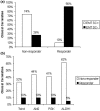Stem cell and epithelial-mesenchymal transition markers are frequently overexpressed in circulating tumor cells of metastatic breast cancer patients
- PMID: 19589136
- PMCID: PMC2750105
- DOI: 10.1186/bcr2333
Stem cell and epithelial-mesenchymal transition markers are frequently overexpressed in circulating tumor cells of metastatic breast cancer patients
Abstract
Introduction: The persistence of circulating tumor cells (CTC) in breast cancer patients might be associated with stem cell like tumor cells which have been suggested to be the active source of metastatic spread in primary tumors. Furthermore, these cells also may undergo phenotypic changes, known as epithelial-mesenchymal transition (EMT), which allows them to travel to the site of metastasis formation without getting affected by conventional treatment. Here we evaluated 226 blood samples of 39 metastatic breast cancer patients during a follow-up of palliative chemo-, antibody - or hormonal therapy for the expression of the stem cell marker ALDH1 and markers for EMT and correlated these findings with the presence of CTC and response to therapy.
Methods: 2 x 5 ml blood was analyzed for CTC with the AdnaTest BreastCancer (AdnaGen AG) for the detection of EpCAM, MUC-1 and HER2 transcripts. The recovered c-DNA was additionally multiplex tested for three EMT markers [Twist1, Akt2, PI3Kalpha] and separately for the tumor stem-cell markers ALDH1. The identification of EMT markers was considered positive if at least one marker was detected in the sample.
Results: 97% of 30 healthy donor samples investigated were negative for EMT and 95% for ALDH1 transcripts. CTC were detected in 69/226 (31%) cancer samples. In the CTC (+) group, 62% were positive for at least one of the EMT markers and 69% for ALDH1, respectively. In the CTC (-) group the percentages were 7% and 14%, respectively. In non-responders, EMT and ALDH1 expression was found in 62% and 44% of patients, in responders the rates were 10% and 5%, respectively.
Conclusions: Our data indicate that a major proportion of CTC of metastatic breast cancer patients shows EMT and tumor stem cell characteristics. Further studies are needed to prove whether these markers might serve as an indicator for therapy resistant tumor cell populations and, therefore, an inferior prognosis.
Figures



References
-
- Braun S, Vogl FD, Naume B, Janni W, Osborne MP, Coombes RC, Schlimok G, Diel IJ, Gerber G, Gebauer G, Pierga JY, Marth C, Oruzio D, Wiedswang G, Solomayer EF, Kundt G, Strobl B, Fehm T, Wong GY, Bliss J, Vincent-Salomon A, Pantel K. A pooled analysis of bone marrow micrometastasis in breast cancer. N Engl J Med. 2005;353:793–802. doi: 10.1056/NEJMoa050434. - DOI - PubMed
-
- Kasimir-Bauer S, Mayer S, Bojko P, Borquez D, Neumann R, Seeber S. Survival of tumor cells in stem cell preparations and bone marrow of patients with high-risk or metastatic breast cancer after receiving dose-intensive or high-dose chemotherapy. Clin Cancer Res. 2001;7:1582–1588. - PubMed
-
- Braun S, Kentenich C, Janni W, Hepp F, de Waal J, Willgeroth F, Sommer H, Pantel K. Lack of effect of adjuvant chemotherapy on the elimination of single dormant tumor cells in bone marrow of high-risk breast cancer patients. J Clin Oncol. 2000;18:80–86. - PubMed
MeSH terms
Substances
LinkOut - more resources
Full Text Sources
Other Literature Sources
Medical
Research Materials
Miscellaneous

